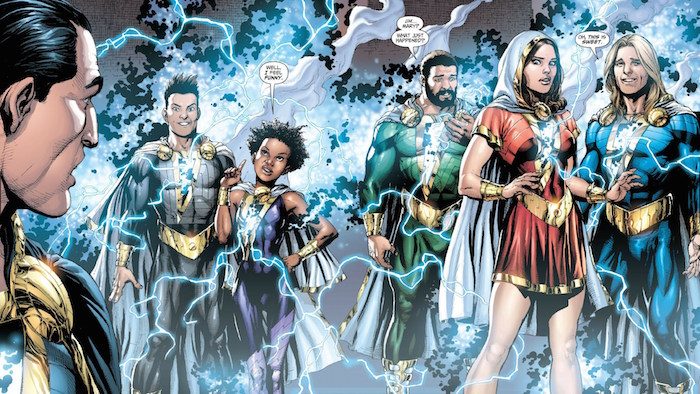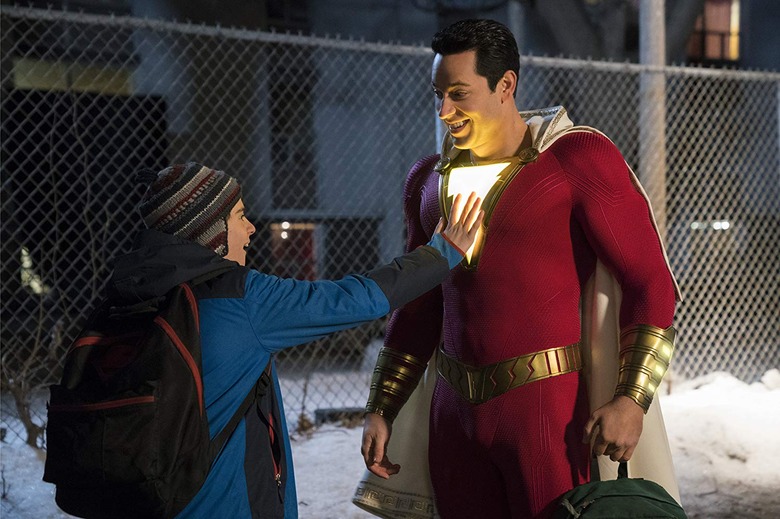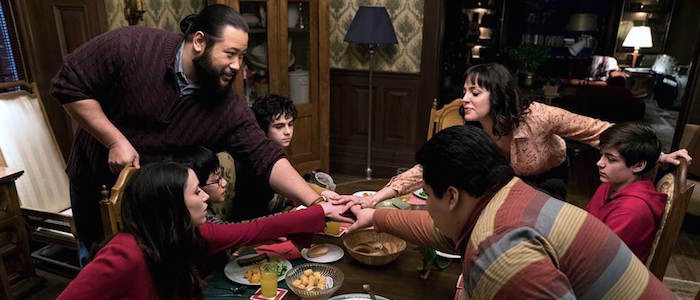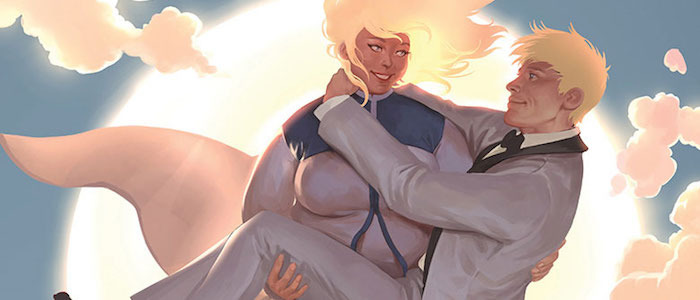'Shazam!' May Be The The Most Positive Superhero Movie Ever Made – But It Has One Serious Failing
(Welcome to The Soapbox, the space where we get loud, feisty, political, and opinionated about anything and everything. In this edition: Shazam! is a delightful movie about finding your ideal self – but it fails in one key way.)Shazam! continues the onscreen DC Universe's pivot to brighter, more joyful entertainment and it does it with a big, goofy grin on its face. Honestly, I can't remember the last time I saw a movie that felt more genetically engineered to become the new favorite movie for every 12-year old in the audience. It's funny and exciting and inspiring and just scary enough, recalling the studio films from eras when filmmakers realized that kids like to be tested, to have their bravery proven, at the movies. I am not the target audience for Shazam!, a movie made with kids in mind first, and that's perfectly fine. Me enjoying it a great deal is just a warm and fuzzy side-effect.
But beyond being a thrilling superhero movie, Shazam! is blessed with a giant heart, one that it wears on its sleeve. Like any movie with a big heart, it has a message it wants to share. Unfortunately, Shazam!'s message is one that is hindered by a single choice, one that will not matter to most people in the audience, but stuck out in a way that I have not been able to shake since I saw it. In the middle of one of the most upbeat, positive, and inspiring comic book movies I've ever seen is a single detail that reads not only false, but is genuinely dispiriting.
Naturally, this post contains major spoilers for Shazam! We have to journey deep into the third act to talk about this.
The Idealized Hero
If you're reading this far, you know the drill. 15-year old foster kid Billy Batson (Asher Angel) is granted magical powers by an ancient wizard and when he says "Shazam," he transforms into an adult superhero (a hilarious and totally game Zachary Levi) with powers of flight, super-strength, and more. After an hour of Big-esque shenanigans and amusing abuses of power, Billy learns the Spider-Man lesson: with great power comes great responsibility and so on, and he must use his new abilities to defeat Dr. Thaddeus Sivana (Mark Strong), a dangerous man with a heavy chip on his shoulder empowered by the demonic "Seven Deadly Sins."
That leads up to the climax: Billy and his foster siblings face off against Sivana and his monstrous allies at a Philadelphia fairground. Realizing that his greatest power is not his power but the ability to share the power granted to him by the wizard, Billy grants his newfound family his magical abilities. Freddy (Jack Dylan Grazer), Mary (Grace Fulton), Darla (Faithe Herman), Eugene (Ian Chen) and Pedro (Jovan Armand) transform into superheroes, complete with brightly colored costumes, capes, and glowing lightning bolts on their chests. Cue a final smackdown between the new Shazam family and Sivana's army, complete with adorable quips and adult actors perfectly capturing the joy of their child counterparts.
This sequence is undeniably fun. It's lovely, even. It completes Billy's arc: he has embraced his family and found his team and he has realized that choosing to be alone when others want to love you is an act of self-destruction. This affirming realization is shared with his foster siblings and they too are given the opportunity to become their best selves, to transform into superheroes that reflect their idealized form, to find the caped crusader, the man of steel, the, uh, Aquaman, that lies in the heart of every good person. It's a thematic cousin to Rian Johnson's beautiful Star Wars: The Last Jedi: anyone can be a hero, even a bunch of foster kids from the streets of Philadelphia.
Have I been positive enough yet? I think so. Because now I want to talk about what's sticking in my craw. And that's Pedro.
We're introduced to Billy's foster family with shorthand introductions. Darla is the precocious talker. Mary is the hard worker. Eugene is the gamer. Freddy is the dorky superhero fan. And Pedro is the big kid, the heavyset guy with antisocial tendencies who doesn't make eye contact, who avoids conversation when possible. Even with these simple set-ups, it's possible that everyone in the audience can see themselves in at least one member of this household.
Well, I saw myself in Pedro. As a heavyset guy who grew up being too shy, too anxious, and too embroiled in my own self-loathing over the shape of my body to make many friends, I immediately related to this kid. I would've killed to have Billy's powers, to be able to say a magic word and transform into a muscular superhero with a square jaw. I dreamed of it. In the climax, when Pedro gains the physique of a classical superhero torn straight from a comic book, I recognized the wish fulfillment being brought to life. I knew it in my bones.
But now, years later and perhaps slightly wiser, I realize how dangerous, and misguided, this particular dream was. By presenting a fat kid's idealized self as a classically athletic man, Shazam! is teaching the wrong lesson.
Erasing the Fat Kid
I'm not here to fire my weapon in the culture wars over "fat acceptance." I'm not here to say people's bodies cannot change through hard work and perseverance. I will say that people should be treated with respect and dignity no matter how they look because that's the basic and humane thing to do. I will also say that, regardless of weight, everyone should at least strive to live a healthier life.
But here's the thing: I'm a heavy (i.e., fat) guy. I have always been. I was low-carbing and dieting in the sixth grade. I visited specialists as a young child to learn why I was growing so fast, why I was so much taller and heavier than other kids. It was ultimately chalked up to genetics – it is literally impossible for me to be "thin" in the traditional sense. No matter the diet, no matter the exercise regiment, I was, and am, always going to be a big guy. My body's general shape is not one you usually see wrapped in colorful spandex.
Realizing that, in my adulthood, was a key piece in the puzzle that is my messy mental health. Accepting that I will diet and exercise for the rest of my life without transforming into Henry Cavill in Man of Steel was a sobering but vital realization. My body is simply not built that way. It's written into my DNA. Into my metabolism. I can only strive to live a healthy and happy life and accept that I will always be, well, round in areas that will keep me from the cover of Men's Health magazine.
I know I'm not alone. The stigma against overweight people runs rampant (especially on the hideous hellscape of the internet), but so many heavier folks have no choice in the matter. They're big because they're big. For me, it's a genetic entanglement that even the specialists I used to visit couldn't clearly define for me. For others I know, it's PCOS or other disorders that make weight loss difficult under any circumstance. It's difficult to live in a world that tells us how our body should look in every movie, every advertisement, all the while cursed with the knowledge that no matter how hard you work, you won't look like that.
So while I admire the heart of Shazam! and its message of discovering your true potential, transforming chubby Pedro in a lean superhero with bulging pectoral muscles feels dishonest, an extension of the culture that makes heavy kids feel like shit every single day. To watch an overweight kid become his ideal superhero self and for that ideal superhero self to be the kind of build we see in every other movie and television show is disheartening, a painful reminder that we can only be that in our grandest fantasies. The only way to deal with the fat kid is to erase the fat kid – we can only be happy if we look like a model.
Is it the fault of Shazam! and director David F. Sandberg for not crafting a message that speaks explicitly to me and others like me? Of course not. The movie works and it works well. It's fun. It's funny. It left my heart in a melted puddle on the floor of the theater. However, the transformation of Pedro feels like a missed opportunity, a chance to present a heavy character's idealized, superhero self as a different body type, one more realistic and affirming than what we've seen before.
(I imagine there will also be conversations about how Freddy is no longer disabled when he transforms into a superhero, literally taking flight and leaving his crutch on the ground beneath him after his magical miracle cure. However, that is above and beyond my pay grade and someone more qualified will undoubtedly tackle that soon.)
All Kinds of Bodies
Here's the thing: there have been plenty of fat characters in superhero stories before and truth be told, most of them only add to the stigma. Think of The Blob from X-Men, a character whose obese body is treated as its own super-power. Larger comic book characters are generally defined by their weight and their weight usually defines their power-set. The coolest heroes, the ones who get the be on the cover, are the lean guys or the guys with bulging muscles. The problems discussed above have run rampant in superhero comics for decades, but what else can you expect from a medium that is, at its core, a power fantasy for readers?
So when I watched chubby Pedro become a superhero in Shazam!, I thought about Valiant Comics' Faith, a heavyset superhero who is not defined by her weight. In fact, her weight does not define her powers. Revitalized by a new creative team in recent years, Faith has the power of flight and she's agile and light on her feet – all the while being presented as a plus-size woman. The recent stories featuring the character have been critical and commercial successes for a good reason: they're damn fine superhero stories, told with heart, but they're also brave and bold enough to showcase a happy, healthy plus-size woman who achieves her best self without having to unrealistically transform into a supermodel.
Just look at the image of modern Shazam family below, the current comic book incarnations from which the new movie borrows many of its core ideas. Look at Pedro, standing center in the green costume. Look how he's clearly powerful and fit...but look how he's still a big dude, shaped more like a power-lifter than a sports model. Hell, just look to any "world's strongest man" competitions and you'll see a variety of body types, including men with large bellies, who are pulling off astonishing feats of strength.

This may still be an idealized superhero body, but it's one that feels attainable, one that feels at least somewhat realistic, and most importantly, one that tells readers "Hey, people are different shapes and not everyone is going to look like Superman and that's okay." Early in the film, there's a brief reference to Pedro leaving one of his weights lying on the kitchen table, suggesting that he's actually working out and keeping himself in shape despite being a heavy guy. The film could've leaned into this, especially with the casting of his superhero self. It does not. And that's a shame.
When the credits rolled on Shazam! and the theater emptied into the lobby, I noted a half dozen younger kids zooming around the lobby, arms outstretched, recreating action scenes from the movie. They loved the film. Of course they did. It's a joy. But I was also tinged with a familiar melancholy. Here was a superhero movie that had a chance to tell the heavy kids in the audience that they, too, could be heroes, even if they would never look like Jason Momoa or Zachary Levi. Here was a superhero movie that had the chance for a heavy character to achieve his ideal form and find it to be, well, himself and not a total fantasy built around typical expectations.
Shazam! is a very good movie, one that I can imagine digging itself deep into young minds with its messages of hope, family, and self-confidence. And yet, it still leaves the fat kid in me sad to know that I will only ever be a superhero if I look like that.



